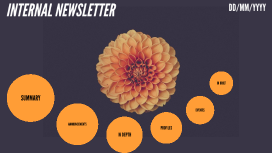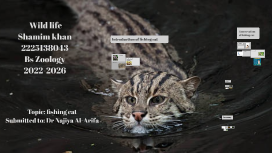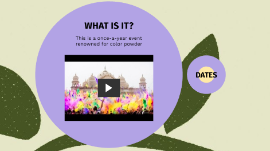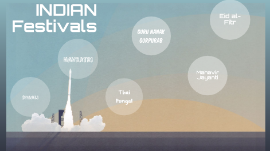INDIAN FESTIVAL
Transcript: INDIAN Festivals DIWALI DIWALI Diwali or Deepavali is the Hindu festival of lights celebrated every year in autumn in the northern hemisphere (spring in southern hemisphere).[3][4] It is an official holiday in Fiji, Guyana, India,[5] Malaysia, Mauritius, Myanmar, Nepal, Singapore, Sri Lanka, Suriname, Trinidad and Tobago, and recently Sindh Province in Pakistan. One of the most popular festivals of Hinduism, it spiritually signifies the victory of light over darkness, good over evil, knowledge over ignorance, and hope over despair.[6][7][8] Its celebration includes millions of lights shining on housetops, outside doors and windows, around temples and other buildings in the communities and countries where it is observed.[9] The festival Navratri Navratri Navratri (Sanskrit: नवरात्रि, literally "nine nights"), also spelled Navaratri or Navarathri, is a multi-day Hindu festival celebrated in the autumn every year. It is observed for different reasons and celebrated differently in various parts of the Indian subcontinent.[2][1] Theoretically, there are four seasonal Navratri. However, in practice, it is the post-monsoon autumn festival called Sharad Navratri that is the most observed in the honor of the divine feminine Devi (Durga). The festival is celebrated in the bright half of the Hindu calendar month Ashvin, which typically falls in the Gregorian months of September and October.[2][3] Thai Pongal Thai Pongal hai Pongal (Tamil: தைப்பொங்கல், /ˈθaɪˈpoʊŋʌl/) is a Tamil harvest festival. Thai Pongal is a four-day festival which according to the Gregorian calendar is normally celebrated from January 14 to January 16.[2] This corresponds to the last day of the Tamil month Maargazhi to the third day of the Tamil month Thai. Thai Pongal is one of the most important festivals celebrated by Tamil people[3][4] in the Indian state of Tamil Nadu, the Indian Union Territory of Puducherry,[5][6]and the country of Sri Lanka,[7][8][9] as well as Tamils worldwide, including those in Malaysia,[10][11] Mauritius, South Africa,[12][13] United States, Singapore,[14] Canada[15][16] and UK.[17] Thai Pongal corresponds to Makara Sankranthi, the winter harvest festival celebrated throughout India. Guru Nanak Gurpurab Guru Nanak Gurpurab Guru Nanak Gurpurab, also known as Guru Nanak's Prakash Utsav and Guru Nanak Jayanti, celebrates the birth of the first Sikh Guru, Guru Nanak.[1] This is one of the most sacred festivals in Sikhi.[2] The festivities in the Sikh religion revolve around the anniversaries of the 10 Sikh Gurus. These Gurus were responsible for shaping the beliefs of the Sikhs. Their birthdays, known as Gurpurab (or Gurpurb), are occasions for celebration and prayer among the Sikhs. Mahavir Janma Kalyanak, is one of the most important religious festival for Jains. It celebrates the birth of Mahavira, the twenty-fourth and last Tirthankara of Avasarpiṇī[a]. As per the Gregorian calendar, the holiday occurs either in March or April.[4] Most modern historians consider Vasokund as Mahavira's birthplace.[5] According to Jain texts, Mahavira was born on the thirteenth day of the bright half of the moon in the month of Chaitra in the year 599 BCE (Chaitra Sud 13).[6][7] Mahavira was born in a democratic kingdom (Ganarajya), Vajji, where the king was chosen by votes. Vaishali was its capital.[8] Mahavir Jayanti Mahavir Jayanti Eid al-Fitr (Arabic: عيد الفطر ʻĪd al-Fiṭr, IPA: [ʕiːd al fitˤr], "feast of breaking the fast")[2] is an important religious holiday celebrated by Muslims worldwide that marks the end of Ramadan, the Islamic holy month of fasting (sawm). The religious Eid (Muslim religious festival) is the first and only day in the month of Shawwal during which Muslims are not permitted to fast. The holiday celebrates the conclusion of the 29 or 30 days of dawn-to-sunset fasting during the entire month of Ramadan. The day of Eid, therefore, falls on the first day of the month of Shawwal. The date for the start of any lunar Hijri month varies based on the observation of new moon by local religious authorities, so the exact day of celebration varies by locality. Eid al-Fitr Eid al-Fitr

















